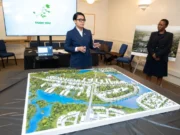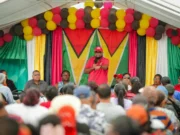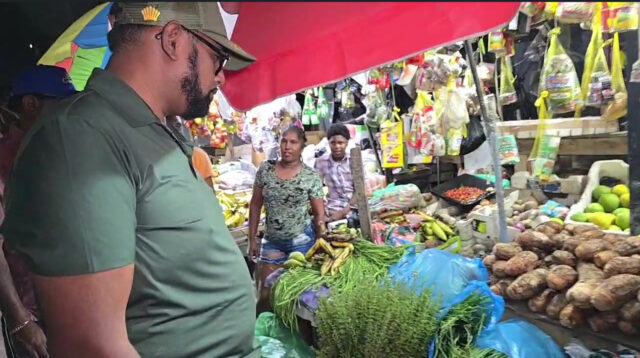At the crack of dawn on Wednesday, President Dr. Irfaan Ali made an impromptu visit to the Bourda Market to “see wuh going on,” as he told one curious passer-by. Treading east down Robb Street, in the company of the Minister within the Ministry of Local Government and Regional Development, Anand Persaud, the president stopped at several stalls where he listened to vendors’ concerns and ascertained the costs of varying cash crops.
His first stop was at the stall of a female vendor and her partner. The couple informed the Guyanese leader that they usually purchase their goods from Parika.
The president asked, “How much fuh a pound of eddoe?”
The vendor said, “All like you, you gon get for $240. It raise right now. It scarce.”
Ali then enquired about the retail price for cassava, to which the vendor said is $100 per lbs. As for sweet potato, she said: “Duh is $260 a lbs, duh expensive. Dem is scare items right now.”
The president noted however that there is a surplus of provisions in the interior regions such as Region One. He committed to having this matter addressed.
As he made his way to another vendor, a similar story was heard about the scarcity of certain produce. Ali was told that sweet peppers are now selling for approximately $800 per lbs, local cabbage at $300 per lbs, tomatoes at $400 per lbs and ochro at $160 per lbs.
As he greeted other vendors, the Head of State received more reports about the rising prices of essential cash crops and where scarcity exists.
Additionally, vendors seized the opportunity to complain about the lack of security in the area. In this regard, Ali assured that swift action would be taken by the Guyana Police Force (GPF) to erect a containerised outpost to monitor the activities around the market. He also pledged that better infrastructural facilities would be considered.
Just four days before his visit to the Bourda Market, the president gave an address via his Facebook page regarding the issue of cost of living and how it is affecting ordinary folk around the world.
He noted that there are several factors, well beyond the government’s control, which are impacting high food prices. He cited the COVID-19 pandemic, and the Russia-Ukraine war and unpredictable climatic conditions as the main culprits.
“You have to remember that from 2020 up to 2022, the world went through immense difficulties as a result of the COVID-19 pandemic. Workers were unable to go to the farms and factories…As a result, productivity fell, leading to shortages in food supplies…,” he explained. This he acknowledged has affected prices but stressed that Guyana is not alone in this predicament.
Referencing a report by Global Finance, Ali said 179 out of 194 countries were affected by high inflation rates. Developed countries such as the US and UK he said, recorded inflation rates that reached a 40 year high in 2022. In Canada, it was the highest since 1983 and in the European Union (EU), it was the highest in four decades. “When the inflation rate is high in these nations…we are importing those rising costs,” he said.
Ali noted however that his government has taken several steps to address rising prices. He said these measures, such as financial support to the fisherfolk and farmers, have gone a long way in helping parents through these difficult times.













